Pilots are instinctively and correctly cautious on the base‑to-final turn but examination of accident numbers reveals another dangerous phase of circuit flight
Let’s look at an ATSB report into a fatal accident involving a Liberty XL-2 at a rural property in NSW. The pilot was flying solo, in company with another aircraft. The report says:
The incident
The accompanying pilot landed their aircraft on a private landing area at the Braidwood property about 15 minutes prior to the Liberty’s arrival. That pilot advised the Liberty pilot by phone that the landing area was undulating and not suitable for the Liberty XL-2 aircraft type. Shortly after, witnesses observed the Liberty circling the landing area with a slowing airspeed.
On the second orbit, at about 400 feet above ground level and after crossing the marked end of the landing area, witnesses observed the left wing drop and the aircraft entered a steep rotating descent. The pilot was unable to recover control of the aircraft before it impacted terrain. The pilot sustained fatal injuries and the aircraft was destroyed.
What the ATSB found
Recorded data showed that the pilot was circling the landing area at a height of 200–400 feet. The ATSB also found the aircraft departed controlled flight after slowing and turning downwind with no flap selected. The left wing stalled and this resulted in the aircraft entering into an upright spin at an altitude that limited an effective recovery.
Safety message
The accident highlights the need for pilots to minimise the risk of aerodynamic stall, particularly when in proximity to the ground such as during take-off and landing. Turning manoeuvres at or close to the aircraft’s critical angle of attack, if mishandled, can lead to a stall that may result in the aircraft entering a spin. Pilots can limit their risk of losing control in flight by maintaining situational awareness of the aircraft state while conducting turns, maintaining adequate airspeed through appropriate power application during increased bank angles, and by selecting altitudes to operate at that provide sufficient height to recognise and recover from a stall.
No, not there
If I were to ask you, ‘Where in the circuit are stalls most likely to occur?’, chances are very good you’d say, ‘In the base-to-final turn’. That’s the circuit stall we talk about and train for and, if we’re thinking about stalls during aerodrome or landing area operations, that’s the point where we’re most on guard for stall avoidance.
This emphasis may inadvertently make us complacent about other stall scenarios in the circuit. And importantly, the base-to-final turn is statistically one of the least likely stall scenarios to result in an accident.
In 2017 the US Aircraft Owners and Pilots Association’s (AOPA) Air Safety Institute published a report, Stall and Spin Accidents: Keep the Wings Flying. The study included all stall-related crashes that resulted in a US National Transportation Safety Board investigation in the years 2000 through 2014.
There were 2,015 stall-related accidents during this five-year sampling; there is a lot more personal aeroplane operation in the US than in Australia, one by-product of which is (unfortunately) a large number of accident reports from which to draw trend information.
The base-to-final turn is statistically one of the least likely stall scenarios to result in an accident.
Figure 1 shows the phase of flight in which these stalls occurred, and the relative deadliness. By eliminating stalls following power loss, including fuel mismanagement, and those reports of stalls during manoeuvring flight away from an airfield, I was able to focus on cases of aerodynamic stall in the circuit that were solely the result of loss of aircraft control (figure 2). The results challenge the conventional wisdom of risk management and flight instruction.
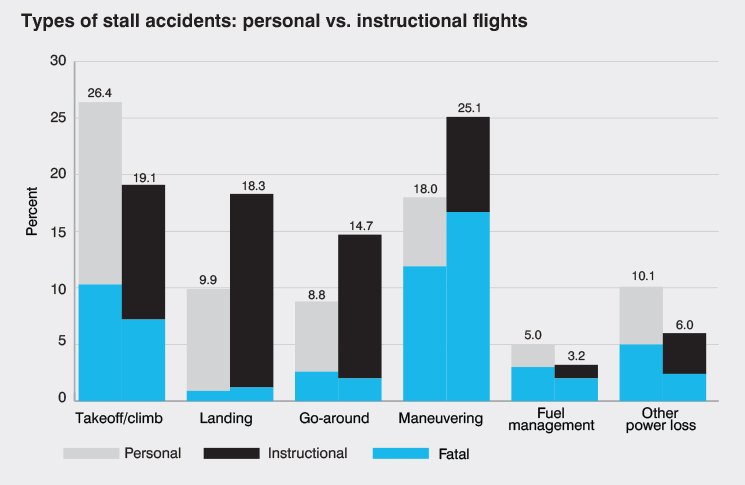
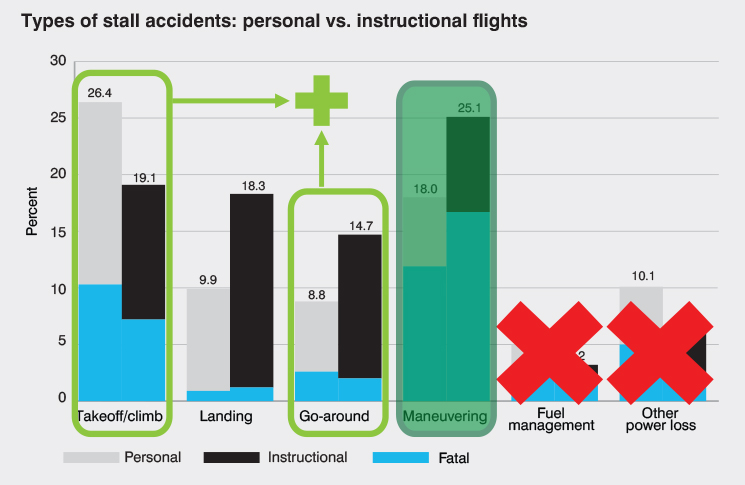
Where do stalls occur?
The data show less than 4 per cent of all stall crashes happened at the base-to-final turn or the turn from downwind to base. Although only 3.8 per cent of the mishaps happened here – since these turns are done close to the ground with little to no opportunity to recover – when they do occur, they are frequently fatal.
Sixty-six per cent of the downwind-to-base stalls and 80 per cent of base-to-final stalls, result in death, according to the US statistics. Stalls in these turns proves to be a low probability/high deadliness risk, worthy of our continued emphasis.
Another 6 per cent occurred on final approach, after completing the turn to final. These stalls were fatal 40 per cent of the time – occurring close to the ground, the aeroplane does not have as far to fall and more impacts were survivable. Backing up in the circuit, the crosswind, downwind and base legs (excluding the turns), resulted in less than 1 per cent of the stalls. A little more than half of these stalls were fatal.
Of all the NTSB-reported stalls in the 5-year study, only 10.7 per cent were crosswind, downwind, final approach, downwind-to-base turn or base-to-final turn. Although stalls in these legs have a high rate of deadliness, they are far from the most common types of traffic pattern stalls. So where do most pattern stalls occur?
Over the runway, and beyond
More than 21 per cent of circuit stalls occurred over the runway during the landing flare. This is twice the number we saw in the entire circuit to this point. Stalls in the flare are usually described as a hard landing – one damaging enough to result in an accident investigation. However common, stalls in the flare are rarely lethal, with only 8 per cent resulting in a fatality. Add these landing-flare stalls to those we saw in the circuit before them, and we still have a little less than one-third of all the stalls investigated by the NTSB and included in the AOPA report. So where do two-thirds of the circuit stalls take place?
About 18 per cent happen during the early stages of a go-around. And 25 per cent of the stalls that occur during a go-around are fatal. By far, however, most aerodrome or landing area circuit stalls occur during initial climb or on the upwind leg: 50.3 per cent of all circuit stalls, and 40 per cent of these stalls resulted in death. Combine the go-around and initial climb stalls, and you have more than two-thirds of all stalls in the circuit.
Put another way, where we think we’ll stall – the downwind-to-base and base-to-final turns and the rest of the arrival circuit – account for only 10.7 per cent of actual stalls, while stalls during the landing flare, the early stages of a go-around and especially the initial takeoff (excluding power loss events) account for 89.3 per cent (figure 3).
Power-off stalls are rampant at a point we don’t usually think about stalls at all – the landing flare.
Power off, power on
Let’s look at it a different way. A little less than one-third of all pattern stalls occur at low power, the type of stall we practise most often. Over two‑thirds of all circuit stalls occur during power-on phases of flight – the type of stall we don’t usually practise as often, since your initial training (figure 4) – it is part of the PPL syllabus. And when we do practise power-on stalls, we almost never practise in the take-off or go-around flap and landing gear configuration. The first time a pilot sees a real-world stall in the circuit is probably in a phase of flight they do not expect, in a configuration they have not practised. No wonder they happen so often!

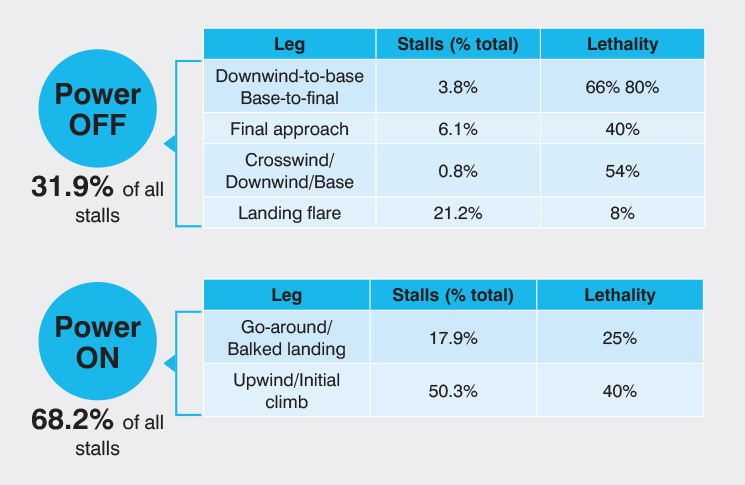
Visualising the scenario
With what we’ve learnt from the institute’s study, let’s look back at the Liberty crash. The ATSB report describes the final moments of flight in the accident cited above:
‘… after crossing the marked end of the landing area, witnesses observed the left wing drop and the aircraft entered a steep rotating descent … The pilot was circling the landing area at a height of 200–400 feet. The ATSB also found that the aircraft departed controlled flight after slowing and turning downwind … ’
Visualising the scenario, the Liberty pilot appears to have been ‘dragging the field’, that is, making a low pass to evaluate the landing surface prior to committing to a landing attempt. One hazard of this practice is that the pilot’s attention may be focused to looking at the ground to the exclusion of those aerodynamic cues necessary for safe, controlled flight. Another is that while maintaining this focus, the pilot may be manoeuvring close to the ground, requiring a steep bank angle to remain within close proximity of the landing surface for visual inspection.
Last, a prime hazard is the slow speed and low altitude required to see the surface well enough to make any meaningful judgment about its suitability for landing. Forget that a second pilot already told the Liberty pilot the area was unsuitable for their aeroplane type, from a vantage point on the ground. From a slow speed and low altitude, with yaw introduced by inadequate rudder or even simply by aileron deflection so close to stall angle of attack, and perhaps with no thought about stalling at this place in the circuit because it was not a base-to-final turn, it seems almost inevitable that the wing would drop and control would be lost with no chance of effecting a recovery.
Training for success
What does the circuit stall record suggest? First, we seem to be doing a fairly good job of teaching power‑off stall avoidance. However, power‑off stalls are rampant at a point we don’t usually think about stalls at all – the landing flare – and result in a damaging, hard landing.
Teaching this avoidance causes us to practise power-off landing configuration stalls more often and think more about them when flying the circuit. This may be what makes us much less likely to stall during the arrival phase.
Second, stalls during take-off, initial climb and go-arounds are far more common than we think. Flying a power-on stall using the usual training and checkride techniques is uncomfortable, and frankly difficult to reproduce in most aeroplanes for most pilots, and even their instructors. The way we train and evaluate power on stalls, usually in a ‘clean’ configuration, makes getting the aeroplane to stall at all challenging – leading us to believe, ‘There’s no way I’d do that accidentally’.
Stalls during take-off, initial climb and go-arounds are far more common than we think.
As a result, we tend to practice power-on stalls less frequently and almost never practise them in the take-off or go-around configuration that can cause a more dramatic departure from controlled flight than when flaps and gear are up.
We need to carefully practise realistic power-on stalls and do so more frequently, to avoid these most common stall scenarios. I can’t emphasise enough the need for rudder coordination.
Last, any traffic pattern stall more than a few feet above the ground can be deadly. So more focus on high angle of attack flight characteristics in all flight regimes is vital to safety. We must stall regularly and realistically for proficiency, and then fly the circuit deliberately to avoid stalls.
The ATSB report says: ‘Maintaining adequate airspeed through appropriate power application during increased bank angles is essential to maintain a controllable airspeed and margin above the stall, especially in slow speed flight, without height loss.’
Rick Beach, one of the founders of the Cirrus Owners and Pilot Association’s pilot training program, is famous (at least in some circles) for observing that loss of control of the aeroplane is always preceded by loss of command of that aeroplane. The lesson of the tragic Liberty stall/spin crash, and of all stalls in the aerodrome or landing area circuit, is to maintain control of the aeroplane by anticipating and avoiding the multiple, sometimes surprising, ways circuit stalls occur.
|
See Advisory circular 61-16 v1.0 – Spin avoidance and stall recovery training |

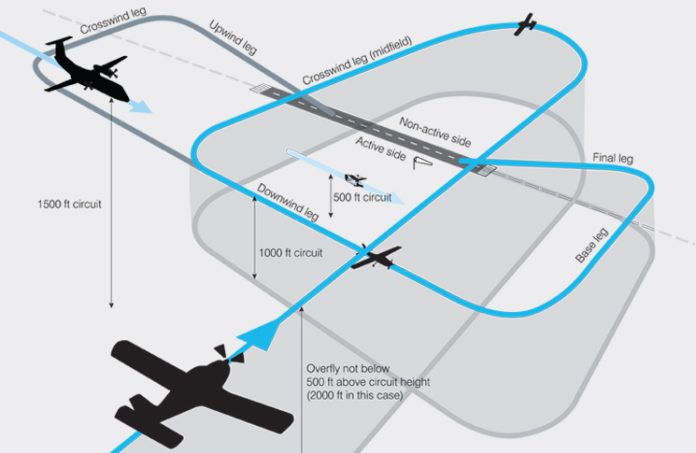
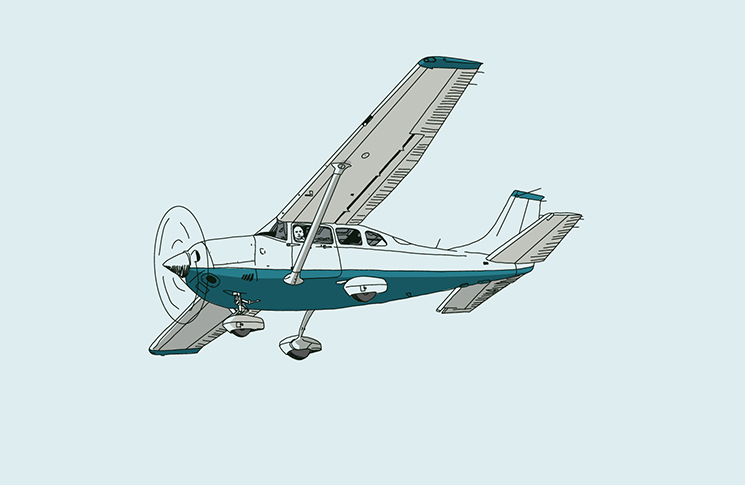
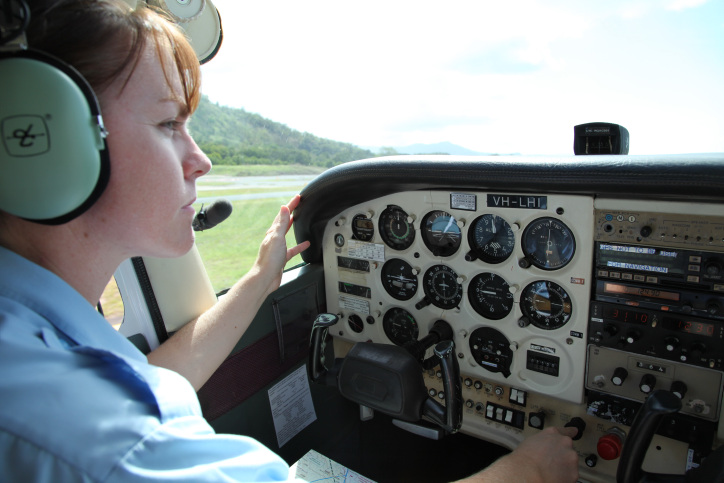


Interesting and well researched.
Not all stalls are the same, I wonder what aircraft types are under represented in fatalities
very clear and good article easy to understand. Thank you
Great analysis, thanks.
Would love to see the go-around stats broken down again by flight hours at time of accident compared to other accidents. I have a personal theory about practicing go-arounds in the early stages of training.